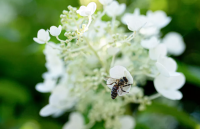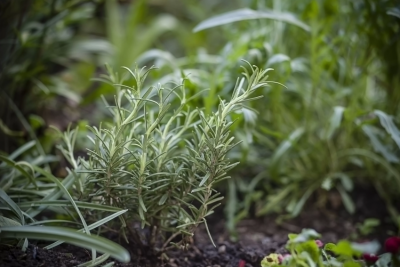Every garden needs pollinators and bees are among the best. Without them, there would be limited flowers and even fewer fruits and vegetables. Since bees add more than a soothing buzzing sound, it’s worth putting some thought into making your garden inviting for them.
Bees are basically looking for two things when they visit your plants:
- Nectar: Nectar is loaded with sugars and it’s a bee’s main source of energy.
- Pollen: Pollen provides a balanced diet of proteins and fats.
Many popular flower varieties are hybridized for features that are valued by the gardener, like disease resistance, flower size or color and bigger, longer blooms. Unfortunately, hybridization has reduced the production of nectar and pollen and sometimes leaves the resulting plant completely sterile and useless to bees and other pollinators. Another factor is that the amount of nectar secreted is dependent on climate conditions such as temperature, humidity, and moisture in the soil.

General Gardening Advice
Here is some advice from the Xerces Society on what to plant to attract more bees to your garden.
- Don’t use pesticides
- Use local native plants
- Chose several colors of flowers
- Plant flowers in clumps
- Include flowers of different shapes
- Have a diversity of plants flowering all season
- Plant where bees will visit
Choosing the Right Flowers
To help bees and other pollinator insects like butterflies, you should provide a range of plants that will offer a succession of flowers, and thus pollen and nectar, through the whole growing season. Patches of foraging habitat can be created in many different locations, from backyards and school grounds to golf courses and city parks. Even a small area planted with good flowers will be beneficial for local bees because each patch will add to the mosaic of habitat available to bees and other pollinators.

Native plants are usually best for native bees and can be used in both wild areas and gardens. There are also many garden plants—particularly older, heirloom varieties of perennials and herbs—that are good sources of nectar or pollen. Together with native plants, these will make a garden attractive to both pollinators and people.
This list is not exhaustive; there are many other plants that are good for bees. Individual species have not been included because the list is meant to be useful across the U.S. Not all of these genera will have species in your local area, but they do represent plants that will grow in a variety of environments. Use a wildflower guide or contact local nurseries to find your local species.
Below are lists of native plants, the other cultivated garden plants. They are not an exhaustive listing of suitable plants for all areas and you may have to research which species are local to your area, but they provide a good starting point. These lists can help you choose the right plants for your area. A field guide will tell you which species from these lists are local to you. Your local chapter of the Native Plant Society and native plant nurseries are worthwhile contacts for advice on choosing, obtaining, and caring for local plant species.
- Aster Aster
- Black-eyed Susan Rudbeckia
- Caltrop Kallstroemia
- Creosote bush Larrea
- Currant Ribes
- Elder Sambucus
- Goldenrod Solidago
- Huckleberry Vaccinium
- Huckleberry Vaccinium
- Joe-pye weed Eupatorium
- Lupine Lupinus
- Oregon grape Berberis
- Penstemon Penstemon
- Purple coneflower Echinacea
- Rabbit-brush Chrysothamnus
- Rhododendron Rhododendron
- Sage Salvia
- Scorpion-weed Phacelia
- Snowberry Symphoricarpos
- Stonecrop Sedum
- Sunflower Helianthus
- Wild buckwheat Eriogonum
- Wild-lilac Ceanothus
- Willow Salix
Garden Plants for Bees
Flower beds in gardens, business campuses, and parks are great places to have bee-friendly plants. Native plants will create a beautiful garden but some people prefer “garden” plants. Many garden plants are varieties of native plants, so this list only includes plants from other countries—”exotic” plants—and should be used as a supplement to the native plant list. As with the native plants, this list is not exhaustive.
- Basil Ocimum
- Cotoneaster Cotoneaster
- English lavender Lavandula
- Giant hyssop Agastache
- Globe thistle Echinops
- Hyssop Hyssopus
- Marjoram Origanum
- Rosemary Rosmarinus
- Wallflower Erysimum
- Zinnia Zinnia

Adapted from a fact sheet of the Pollinator Conservation Program, Xerces Society April 2004.
To read the full information on this topic, please go to: https://www.thespruce.com/bee-plants-1401948
Photo credits to: https://www.thespruce.com.
